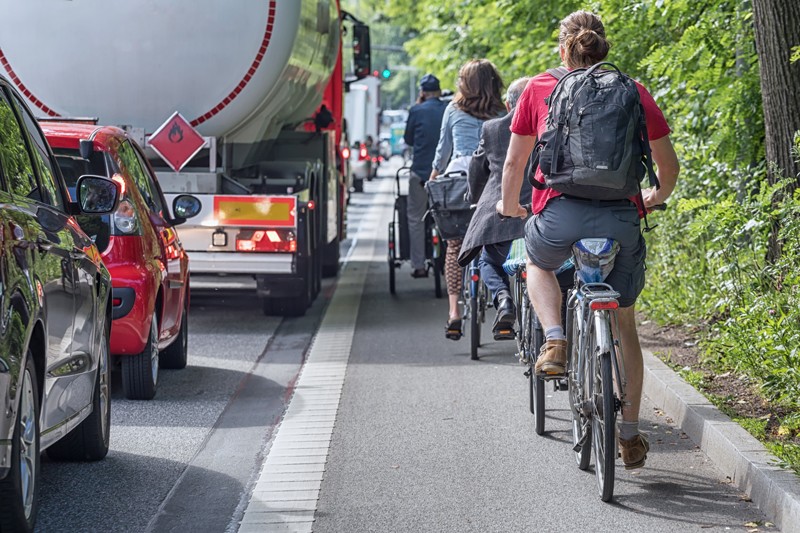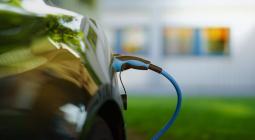Running a car costs much more than people think — stalling the uptake of green travel

Car owners underestimate total vehicle costs. Giving consumers this information could encourage the switch to cleaner transport and reduce emissions.
Private cars are responsible for about 11% of the world’s total carbon dioxide emissions. That’s the greatest share in the transport sector, which accounts for 24% of emissions overall1. Petrol and diesel cars are associated with many other harmful effects, such as air pollution, congestion and accidents. It is clear that these cars must be largely removed from the roads to achieve sustainable mobility.
The good news is that some policies have been enacted to reduce greenhouse-gas emissions and air pollution from petrol and diesel cars. Some markets have tightened emissions limits. In the European Union from 2021 onwards, for instance, the fleet-wide average emission target for new cars will be reduced by more than 25% — from 130 grams of CO2 per kilometre (g CO2 km–1) in 2015–19 to 95 g CO2 km–1. The current average is 120 g CO2 km–1 (on the basis of 2018 data; see go.nature.com/39puqyy). And the United Kingdom will stop sales of new petrol, diesel and hybrid cars from 2035 onwards.
Cities are taking action, too. For example, Oslo has decreased the number of parking spots and raised parking fees2. New York City and Shenzhen in China are electrifying their bus fleets, and London is reducing bus emissions and improving infrastructure for walking and biking. Stuttgart in Germany is among the cities banning older, polluting diesel cars.
The bad news is that more than 99% of new passenger cars sold worldwide still rely on fossil fuels1,3, and overall vehicle ownership in Europe grew by 25% between 2000 and 20174. The continued demand for vehicle ownership stems from several factors, including increased income5 and more mobility as people travel farther to their jobs as a result of greater city sprawl6. The transition away from conventional vehicles is hindered by the high upfront costs of electric cars7–9 and too few charging stations, leading to ‘range anxiety’ from potential owners10,11
Consumers decide whether to own a vehicle on the basis of considerations such as where they live and the vehicle’s upfront and lifetime costs12. If they systematically underestimate total costs, this could increase car ownership and its associated emissions. It could also make alternative forms of transport — car sharing, alternative-fuel vehicles, public transport, biking or walking, say — seem less attractive.
We surveyed more than 6,000 citizens across Germany to investigate whether consumers grasp the total cost of car ownership. We also performed a simple analysis to explore the potential implications of this awareness on the number of cars on the road.
We find that people underestimate the total cost of owning a car by about 50%. We also found that providing personalized information on the costs of car ownership increased respondents’ willingness to pay for a public-transport ticket by around 22% (see Supplementary information; SI). We estimate that educating people in Germany about the true cost could reduce car ownership by up to 37% and cut associated transport emissions by 23%. Here, we suggest labelling and communication policies that could help to speed the transition to cleaner transport.
Data set and methods
We conducted a survey of the heads of German households — the people who self-report as being responsible for financial decisions — between 23 April and 12 June 2018. For every car owner, the survey elicited responses on the cost of ownership, based on the individual’s car type and driving behaviour, as well as socio-economic characteristics such as income, number of children and education. The work was done in collaboration with the survey institute Forsa in Berlin. It used a random sample of Forsa’s household panel, which is representative of the German-speaking population aged 14 and older.
Of the 7,823 individuals who started the survey, 6,812 completed it, 6,233 of whom own a car (92%). Of these, 5,483 stated what they thought their monthly car costs were. These respondents form the basis for our analyses. Taking households’ car type and travel behaviour into account, we use detailed information from the German Automobile Club (ADAC) and other sources to calculate the actual monthly costs of car ownership, on average, for depreciation, fuel, taxes and insurance, and repair (see SI).
Striking difference
Our findings were striking. Consumers underestimate the total cost of vehicle ownership by €221 (US$240) per month on average. The misjudgement amounts to 52% of the actual costs, so the total cost is nearly twice what people think. Using only the respondents who provided an estimate for all cost factors, the underestimation is €161 on average, which is 35% of the actual costs. To be conservative, we proceed in our analysis using this sample (for the full sample, see SI).
The difference between estimates and actual costs varies widely. This is not necessarily surprising. The mean and median of the difference is well below zero, clearly demonstrating that costs are underestimated on average.
We also investigated the four main costs of car ownership: fuel, depreciation, repair, and tax and insurance. On average, respondents came very close to perfectly estimating how much they spent on fuel, consistent with the previous literature13. But they severely underestimated all other major expenditure for running their cars (see ‘Costly misjudgement’). To our knowledge, this misjudgement has not been reported previously, and it can provide leverage points for designing new transport policies.

Fewer cars
Let’s assume that it is possible to completely eliminate the degree to which people systematically underestimate the total cost of owning a car. Would this change the number of cars on the road? We explored this question by modelling how car ownership changes when the associated costs change, on the basis of previous work on US car ownership12. This allowed us to calculate the reduction in the 47.1 million passenger cars in Germany that one might expect if households were perfectly informed about running costs.
We predict that being aware of the true cost of owning a car could result in almost 17.6 million (37%) fewer vehicles on the road in Germany. Such a drastic reduction would mean less congestion and cleaner air. It would also lead to a drop in CO2 emissions of about 37 million tonnes per year: 4.3% of Germany’s total, or 23% of emissions from its transportation sector (see SI).
Although increased demand for public transport could lead to more CO2 emissions from bus and rail travel, this effect would probably be small. First, the carbon emissions per person for each kilometre travelled for these modes of transport are around half those of car travel (see go.nature.com/2upeejh). Second, emissions-trading schemes in the EU, for example, mean that the increased electricity consumed by the growing number of electric trains and vehicles is prevented from translating into extra carbon emissions for the economy, because total emissions are capped.
Even a more cautious estimate of changes in car ownership in response to higher prices of new vehicles (as reported in a 2018 US impact analysis14) would still imply a 9% reduction in car ownership, taking more than 4 million cars off German roads (see SI).
We further used our survey data and empirical estimates of the impact of car-ownership costs to investigate whether such misjudgements affect the use of public transport and electric vehicles. We predict an increase in demand for bus and rail travel of 8% and 12%, respectively. Purchases of electric vehicles could increase by about 73% (see SI).
Although our survey was conducted in Germany, we expect the results to be applicable throughout Europe, and probably to countries with similar economies elsewhere. In 2017, Germany had 561 passenger cars for every 1,000 inhabitants; the EU average in the same year was 51215. And people in other countries accurately estimate fuel costs13, as in our survey.
These are preliminary findings. Our calculations require a number of assumptions. For example, we had to assume how much car ownership changes when household perceptions of total costs change, and how much the demand for other transport modes would respond to decreased car ownership (see SI, pages 5–6). To explain, consider the case in which the changes in car ownership and the demand for other transport modes were less pronounced. Then, eliminating cost beliefs would have smaller effects.
Critics might argue that cost is merely one of many factors that influence individuals’ decisions to own a combustion-engine car, including status, the need for mobility in rural areas and the lack of infrastructure for electric-vehicle charging and for public transport. Although cost is indeed only one factor, it is a crucial one in the car-ownership decision12,16. Another potential criticism is that our consideration of vehicle list prices does not account for the discounts car buyers usually negotiate, which could partly explain why our respondents underestimated depreciation.
We show that taking typical discounts into account does not change our main conclusions (see SI). Indeed, our approach is conservative because we do not consider other factors that increase the cost of owning a car, such as extra equipment (navigation systems, seat heating and sports seats) or premiums for leasing or financing. These raise car prices by 30–50% on average, and so widen our estimates of ownership-cost misjudgement.

Policy action
It is unlikely that anything will entirely stop people from underestimating the total cost of owning a car. Nevertheless, we think that closing this ‘awareness gap’ can spur the transition away from conventional cars. How do we do this?
Cars should be labelled with total costs at the point of sale and in registration letters. Such information-provision policies influence consumer purchasing behaviour in a variety of contexts, from buying property to durables such as refrigerators and air conditioning17–19. Many countries, including the United States, Japan and China, already mandate that new cars for sale are labelled with the average future fuel cost of driving them.
Companies that promote alternative forms of transport with lower emissions — such as electric-vehicle dealers, car-sharing or public-transport firms — could boost business by including information on the cost of car ownership in their advertising. To prevent potential conflicts of interest, the information would need to be certified or come from trusted sources, such as scientific institutions or public ministries. But even a general marketing campaign could at least encourage consumers to calculate the cost of driving accurately.
How successful might such interventions be, compared with other options such as a fuel tax or subsidizing public transport? We calculate that fuel prices would need to rise by a massive 1,242% to cut car ownership by the same 37% reduction that we predict as a result of improved consumer information (see SI). This is because fuel price changes largely target driving itself, rather than the decision of whether to buy a vehicle.
Another widely discussed policy is to subsidize public transport more. This might have less potential than correcting the misjudgement of car ownership costs. There is no evidence available solely from Germany, so we based our extrapolations on evidence for the relationship between prices for public transport and car ownership. This came from a meta study of 83 papers, predominantly from Europe and the United States20. We find that eliminating public-transport fares entirely would decrease car use by only 4.1–6.2%, and could have an even smaller impact on car ownership. This approach would also be burdensome on the public treasury. In Germany, for example, total ticket sales by local transport companies amounted to €13.3 billion in 2019.
We believe that policies on labelling and information would be less costly and less politically fraught than would many other options. The primary resistance to such a policy might come from conventional car dealers and manufacturers who would be reluctant to see sales fall. But information provision is likely to get strong public support from consumer-protection agencies, for example, which could offset such lobbying. Furthermore, providing ownership cost information could be implemented by revising existing fuel labels, which would reduce institutional obstacles.
Next steps
Future research should focus on total car-ownership costs, rather than on fuel costs alone. To plug knowledge gaps, we have the following recommendations.
We need to know why consumers underestimate the costs of car ownership. This could lead to information targeted to those who make the biggest misjudgements. Campaigns should be tested in the field to guide policymakers who are aiming to promote greener transport.
Our survey should be replicated in other countries to clarify how and where the results apply. This could shed light on what drives the systematic underestimation. Furthermore, future studies should elicit how the underestimation can be reduced, for instance by means of surveys, laboratory experiments and, ideally, field experiments. It would also be useful to investigate the overall impact of car-ownership information on mobility behaviour more broadly, including the use of public transport, cycling and walking. Our analysis uncovered a need for further empirical evidence on the relationship between the cost of car ownership and the number of cars on the roads.
We see great promise in this research agenda to inform policymakers about cost-effective approaches to reducing emissions from transportation. One of the goals of the European Green Deal, proposed by the European Commission last December, is to accelerate the shift to sustainable and smart mobility. And Horizon Europe, the EU’s €100-billion research programme, is currently defining its agenda for research during 2021–27. Both present an invaluable window of opportunity.
Nature 580, 453-455 (2020)
doi: 10.1038/d41586-020-01118-w
20 April 2020
nature





